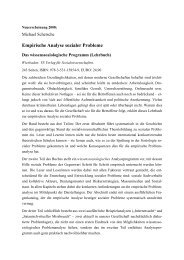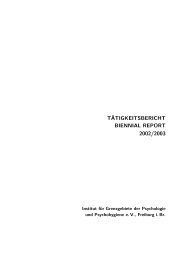Psychophysiology of False Memories in a Deese-Roediger ... - IGPP
Psychophysiology of False Memories in a Deese-Roediger ... - IGPP
Psychophysiology of False Memories in a Deese-Roediger ... - IGPP
You also want an ePaper? Increase the reach of your titles
YUMPU automatically turns print PDFs into web optimized ePapers that Google loves.
<strong>Psychophysiology</strong> <strong>of</strong> Visual <strong>False</strong> <strong>Memories</strong><br />
patients with traumatic bra<strong>in</strong> <strong>in</strong>jury and healthy controls. EDA<br />
responses were recorded dur<strong>in</strong>g recall. Results for the healthy<br />
control group <strong>in</strong>dicated a relationship between EDA responses<br />
and uncerta<strong>in</strong>ty dur<strong>in</strong>g recall. Allen and Mertens [15] comb<strong>in</strong>ed<br />
the DRM paradigm with an event-related potentials-based CIT;<br />
they found ‘‘little evidence that bra<strong>in</strong> electrical activity could<br />
differentiate true from false memories’’.<br />
Aims <strong>of</strong> the present study<br />
The present study was designed to explore whether responses <strong>in</strong><br />
peripheral psychophysiology differ between true and false<br />
memories. This was implemented by comb<strong>in</strong><strong>in</strong>g a DRM paradigm<br />
with electrodermal, cardiovascular, and respiratory measurement.<br />
Operationalization and data reduction were performed accord<strong>in</strong>g<br />
to CIT standards. We hypothesized that response differences<br />
between false and true recognition would be observable,<br />
analogously to the response differences to irrelevant (unknown)<br />
vs. probe (known) items <strong>in</strong> the CIT. Therefore, we expected false<br />
memories to elicit lower EDA, higher respiration l<strong>in</strong>e length,<br />
higher phasic heart rate, and higher f<strong>in</strong>ger pulse waveform length<br />
than true recognition.<br />
Further aims, as methodological advances over Miller and<br />
Gazzaniga’s [9] study design, were the <strong>in</strong>troduction <strong>of</strong> a control<br />
group, the <strong>in</strong>troduction <strong>of</strong> unrelated items, and the use <strong>of</strong> equal<br />
modalities (i.e. pictures only) <strong>in</strong> study and recognition phase.<br />
We argue that the <strong>in</strong>troduction <strong>of</strong> a control group is crucial for a<br />
false memory study us<strong>in</strong>g psychophysiological measures and a<br />
‘‘classical’’ DRM design. Between-group <strong>in</strong>teraction analyses were<br />
planned to control for possible a priori memorability differences<br />
between related lures and studied items. Unrelated items were<br />
<strong>in</strong>troduced as a manipulation check <strong>of</strong> recognition judgments,<br />
similarly to previous DRM studies (see [2]). Additionally, it was<br />
<strong>in</strong>tended to disentangle electrodermal responses related to<br />
orient<strong>in</strong>g and motor activity. For this purpose, a time delay <strong>of</strong><br />
six seconds was <strong>in</strong>serted between item presentation and prompt to<br />
answer.<br />
Materials and Methods<br />
Ethics Statement<br />
This study was approved by the Institutional Review Board <strong>of</strong><br />
the Institute for Frontier Areas <strong>of</strong> Psychology and Mental Health<br />
(Freiburg, Germany) where the study was conducted. Procedures<br />
and measures were expla<strong>in</strong>ed to the participants. Written<br />
<strong>in</strong>formed consent was obta<strong>in</strong>ed from all subjects.<br />
Participants<br />
Sixty students <strong>of</strong> various faculties voluntarily participated <strong>in</strong> the<br />
study. Exclusion criteria were: <strong>in</strong>sufficient language skills,<br />
academic experience <strong>in</strong> psychology or cognitive science, prior<br />
participation <strong>in</strong> an experiment <strong>in</strong> the same laboratory. Two<br />
subjects had to be excluded from the analyses: one due to alertness<br />
problems, one due to mental health problems. The rema<strong>in</strong><strong>in</strong>g<br />
fifty-eight subjects (22 m, 36 f; age 24.363.4 years; 52 righthanded)<br />
were healthy and unmedicated. All subjects received a<br />
compensation <strong>of</strong> twelve Euros for their participation.<br />
Groups<br />
Subjects were assigned pseudo-randomly and without the<br />
knowledge <strong>of</strong> the experimenters to either the control group or<br />
the experimental group. The f<strong>in</strong>al sample consisted <strong>of</strong> twenty-n<strong>in</strong>e<br />
subjects per group. Subjects <strong>of</strong> the experimental group viewed<br />
visual scenes <strong>in</strong> each <strong>of</strong> which one particular object, the ‘‘related<br />
lure’’, had been removed; subjects <strong>of</strong> the control group viewed the<br />
complete scenes. The objects omitted <strong>in</strong> the experimental group<br />
will be referred to as ‘‘related controls’’ <strong>in</strong> the control group,<br />
because there they did not serve as ‘‘lures’’.<br />
Stimuli<br />
The present experiment used 13 digitalized color pa<strong>in</strong>t<strong>in</strong>gs from<br />
the former American weekly periodical ‘‘The Saturday Even<strong>in</strong>g<br />
Post’’ show<strong>in</strong>g stereotypical everyday scenes (e.g. a clean<strong>in</strong>g scene<br />
with a mother and a child display<strong>in</strong>g amongst other th<strong>in</strong>gs a<br />
shovel, a broom, an apron, and a b<strong>in</strong>). Even though the present<br />
study’s learn<strong>in</strong>g phase was strongly <strong>in</strong>spired by Miller and<br />
Gazzaniga [9], we only partially used the same scenes (see<br />
Appendix S2).<br />
All visual scenes had a resolution <strong>of</strong> 500*500 pixels. For the<br />
control group, all scenes rema<strong>in</strong>ed untouched, while for the<br />
experimental group, related lures were removed. Related lures<br />
were chosen <strong>in</strong> terms <strong>of</strong> high relatedness to its category. The<br />
empty surfaces result<strong>in</strong>g from this process were digitally retouched.<br />
One additional visual scene was prepared analogously for a<br />
tra<strong>in</strong><strong>in</strong>g study phase.<br />
For the recognition phase, all related lures and studied items<br />
were cut out <strong>of</strong> their respective scene; all unrelated items were<br />
extracted from scenes taken from other volumes <strong>of</strong> ‘‘The Saturday<br />
Even<strong>in</strong>g Post’’ (see Appendix S1). Presentation angles and aspect<br />
ratios <strong>of</strong> all extracted items were ma<strong>in</strong>ta<strong>in</strong>ed. Each item was<br />
magnified to a maximum size <strong>of</strong> 300 pixels, put on a white<br />
background, and <strong>in</strong>serted <strong>in</strong> a white frame with a width <strong>of</strong> a 100<br />
pixels per side. The result<strong>in</strong>g pictures, 500*500 pixels <strong>in</strong> size, were<br />
surrounded by a grey presentation mask and presented foveally on<br />
a190 monitor at a distance <strong>of</strong> 90 cm. Picture size was 11.95u <strong>of</strong><br />
visual angle <strong>in</strong> both dimensions. Each item category related to a<br />
visual scene comprised three studied items, two unrelated items<br />
and one related lure/related control. A tra<strong>in</strong><strong>in</strong>g recognition phase<br />
consist<strong>in</strong>g <strong>of</strong> one unrelated item and two studied items was also<br />
prepared.<br />
Procedure<br />
Similar to several other DRM studies [6,9,13], we tried to<br />
disguise the study’s true nature <strong>in</strong> order to avoid possible effects <strong>of</strong><br />
forewarn<strong>in</strong>g (see [52–54]). As a cover story, we advertised the<br />
study as a ‘‘series <strong>of</strong> experiments about social perception and<br />
emotion’’ and <strong>in</strong>troduced an irrelevant valence-rat<strong>in</strong>g task <strong>in</strong> the<br />
study phase; <strong>in</strong> a retention <strong>in</strong>terval, participants filled out a<br />
personality questionnaire (<strong>in</strong>cluded for exploratory purposes,<br />
results are not reported here; Tellegen Absorption Scale; [55];<br />
German Version [56]). The reason for the use <strong>of</strong> a cover story was<br />
expla<strong>in</strong>ed to all subjects after complet<strong>in</strong>g the experiment.<br />
(1) Study phase: subjects were led to an acoustically and<br />
electrically shielded, video surveilled, and dimly lit experimental<br />
chamber (Industrial Acoustics GmbH, Niederkrüchten,<br />
Germany) and seated <strong>in</strong> front <strong>of</strong> a monitor; there they<br />
received a written <strong>in</strong>struction for the study phase, ask<strong>in</strong>g<br />
them to first read the title head<strong>in</strong>g (e.g. ‘‘clean<strong>in</strong>g’’) <strong>of</strong> each<br />
picture before tak<strong>in</strong>g a thorough look. They were also asked<br />
to rate the pictures (see cover story) on a rat<strong>in</strong>g scale rang<strong>in</strong>g<br />
from 1 ‘‘very unpleasant’’ to 7 ‘‘very pleasant’’ as soon as<br />
the rat<strong>in</strong>g scale appeared on the screen. After a short<br />
tra<strong>in</strong><strong>in</strong>g phase, the ma<strong>in</strong> run, <strong>in</strong> which all thirteen visual<br />
scenes were presented for 50 seconds <strong>in</strong> a pseudo-randomized<br />
order, was conducted. The rat<strong>in</strong>g scale was presented<br />
after 40 seconds and rema<strong>in</strong>ed until confirmed by the<br />
participant. A gray screen was presented for four seconds<br />
prior to each trial.<br />
PLoS ONE | www.plosone.org 3 January 2012 | Volume 7 | Issue 1 | e30416



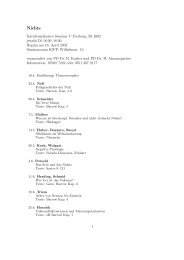
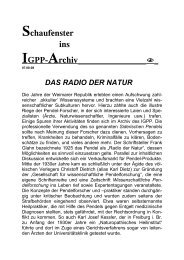
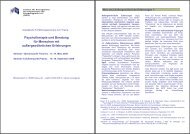
![Findliste Nachträge1 [pdf] - IGPP](https://img.yumpu.com/22552359/1/184x260/findliste-nachtrage1-pdf-igpp.jpg?quality=85)

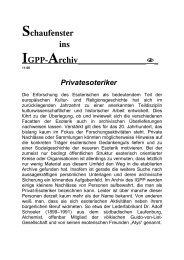
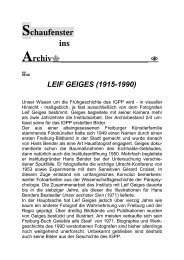
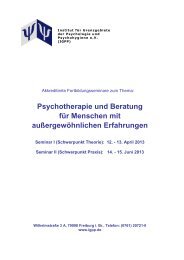
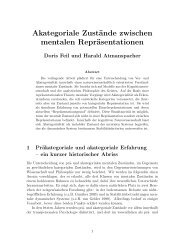
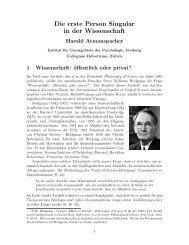
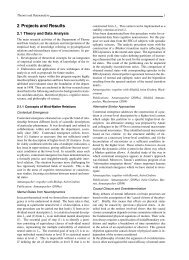
![Findliste [pdf] - IGPP](https://img.yumpu.com/22552265/1/190x245/findliste-pdf-igpp.jpg?quality=85)

